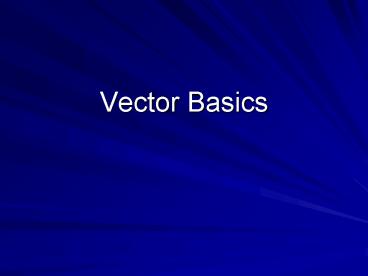Vector Basics PowerPoint PPT Presentation
1 / 18
Title: Vector Basics
1
Vector Basics
2
OBJECTIVES
- CONTENT OBJECTIVE TSWBAT read and discuss in
groups the meanings and differences between
Vectors and Scalars - LANGUAGE OBJECTIVE TSW read and discuss the key
vocabulary words Vectors and Scalars and
Resultants.
3
Scalar
- Scalar quantities only have magnitude (size
represented by a number unit) ex. Include mass,
volume, time, speed, distance
4
Vectors
- Vector quantities have magnitude and direction.
Ex. Include force, velocity, acceleration,
displacement
5
Vector Representation
- Vectors are represented as arrows
- The length of the vector represents the
magnitude
start
end
head or tip
tail
6
Vectors are always drawn to a scale comparing the
magnitude of your vector to the metric scale
- Ex.
- 1.0 cm 1.0 m/s
- Draw a 3.0 m/s East vector
- Vector will be 3.0 cm long
- Ex.
- 1.0 cm 1.5 m/s
- Draw a 3.0 m/s East vector
- Vector will be 2.0 cm long
7
Direction of Vectors
- Direction of vectors is represented by the way
the arrow is pointed - Vector components are based on coordinate plane
so vectors can point in negative or positive
directions
N
Positive X, Positive Y
Negative X, Positive Y
E
W
Negative X, Negative Y
Positive X, Negative Y
S
8
Resultant Vectors
- A resultant vector is produced when two or more
vectors combine - If vectors are at an angle, vectors are always
drawn tip to tail
9
Adding and subtracting vectors Same Direction
- If the vectors are equal in direction, add the
quantities to each other. - Example
the resulting vector is
10
Adding and subtracting vectors Opposite
Directions
- If the vectors are exactly opposite in direction,
subtract the quantities from each other. - Example
the resulting vector is
11
Vectors at Right Angles to each other
- If vectors act at right angles to each other, the
resultant vector will be the hypotenuse of a
right triangle. - Use Pythagorean theorem to find the resultant
12
Pythagorean Theorema2 b2 c2 where c is the
resultant
Hypotenuse resultant vector
c
a
b
13
Example
- A hiker leaves camp and hikes 11 km, north and
then hikes 11 km east. Determine the resulting
displacement of the hiker.
14
112 112 R2
121 121 R2
242 R2
R 15.56 km, northeast
15
Calculating a resultant vector
- If two vectors have known magnitudes and you also
know the measurement of the angle (?) between
them, we use the following equation to find the
resultant vector. - R2 A2 B2 2ABcos?
Use this for angles other than 90º
Make sure your calculator is set to DEGREES! (go
to MODE)
16
Example 1
R
4.0 N, SW
- ? 110
- R2 5.02 4.02 2(5.0)(4.0)(cos 110)
- R2 54.68
- R 7.39 N, Southwest
5.0 N, W
?
17
Example 2
? 35º
- R2 4.32 5.12 (2)(4.3)(5.1)(cos 35)
- R2 8.57
- R 2.93 m, northwest
18
Vector Equations
- Pythagorean Theorema2 b2 c2 where c is the
resultant - Law of Cosines
R2 A2 B2 2ABcos?

